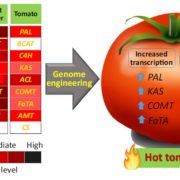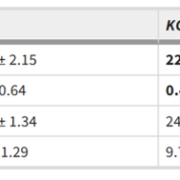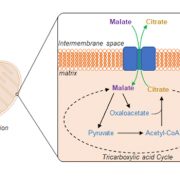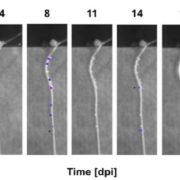Anthocyanins on Demand
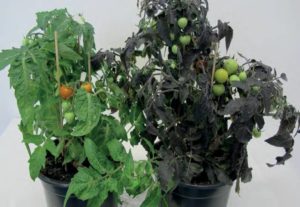 Anthocyanins are vacuolar pigments derived from the phenylpropanoid pathway that are produced in many different plant species. The role of anthocyanin accumulation under stress in vegetative tissues is probably linked to the scavenging of reactive oxygen species (ROS). Anthocyanins are powerful antioxidants and, as part of human diet in seeds, fruit and leaves are proposed to have health promoting properties. It has been shown that the consumption of anthocyanins can lower the risk of cancer, diabetes and cardiovascular diseases. To be able to breed for fruits and vegetables that are rich in anthocyanins, it is important to understand both their biosynthesis and functions in plants. To this end, Outchkourov et al. (10.1104/pp.17.01662) have developed an inducible dexamethasone-regulated switch, which can deliver, on-demand, anthocyanin accumulation in different tissues of the tomato cultivar MicroTom.
Following the application of dexamethasone, anthocyanin formation was induced within 24 h in vegetative tissues and in undifferentiated cells. This inducible system reveals a range of phenomena that accompany anthocyanin biosynthesis in tomato, including profound physiological and architectural changes, depending on the tissue, including root branching, root epithelial cell morphology, seed germination and leaf conductance. A number of pathways that are not known to be involved in anthocyanin biosynthesis were also observed to be regulated.
Anthocyanins are vacuolar pigments derived from the phenylpropanoid pathway that are produced in many different plant species. The role of anthocyanin accumulation under stress in vegetative tissues is probably linked to the scavenging of reactive oxygen species (ROS). Anthocyanins are powerful antioxidants and, as part of human diet in seeds, fruit and leaves are proposed to have health promoting properties. It has been shown that the consumption of anthocyanins can lower the risk of cancer, diabetes and cardiovascular diseases. To be able to breed for fruits and vegetables that are rich in anthocyanins, it is important to understand both their biosynthesis and functions in plants. To this end, Outchkourov et al. (10.1104/pp.17.01662) have developed an inducible dexamethasone-regulated switch, which can deliver, on-demand, anthocyanin accumulation in different tissues of the tomato cultivar MicroTom.
Following the application of dexamethasone, anthocyanin formation was induced within 24 h in vegetative tissues and in undifferentiated cells. This inducible system reveals a range of phenomena that accompany anthocyanin biosynthesis in tomato, including profound physiological and architectural changes, depending on the tissue, including root branching, root epithelial cell morphology, seed germination and leaf conductance. A number of pathways that are not known to be involved in anthocyanin biosynthesis were also observed to be regulated.


